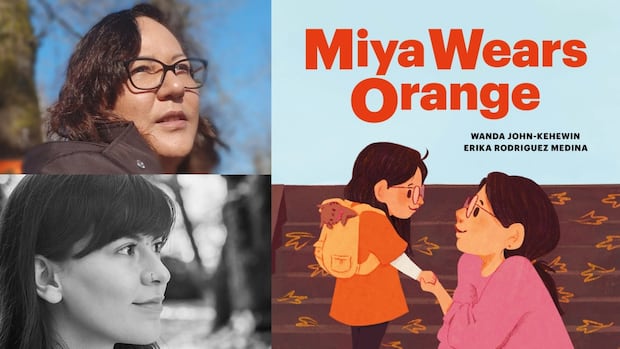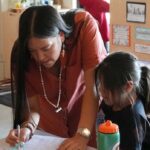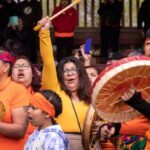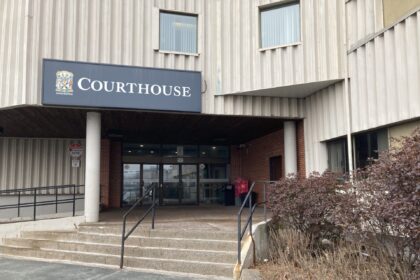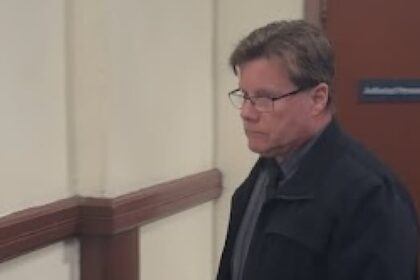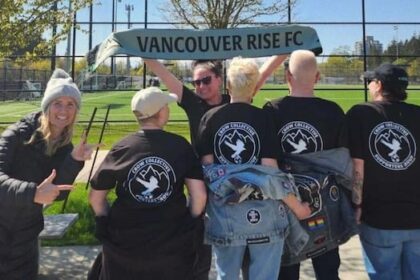When Wanda John-Kehewin’s daughter Miya learned about the history of residential schools in Canada, she worried she might be taken away from her family. That worry sparked a feeling of grief within John-Kehewin. “It was like, OK, well, if she was actually being taken to residential school, then this would be my last night with her,” she said. “I thought about all the different last nights there were with other Indigenous parents who had to actually let their children go.”It impacted her so much, John-Kehewin missed work the next day. And in talking with other Indigenous parents, she learned that other families were coming to terms with something similar — young children learning about the history of residential schools, and wondering whether they were safe. So, as a writer, John-Kehewin turned her experience into a book, one specifically for children who may be learning about the residential school system for the first time. Miya Wears Orange, illustrated by Erika Rodriguez Medina, follows a young girl who learns about the institutions for the first time at school today, and even though her family explains that this is nothing to worry about now, Miya is unsure of what to do with the deep sadness she feels. John-Kehewin, a Cree writer who lives in Coquitlam, B.C., spoke with CBC’s North by Northwest about storytelling and healing. LISTEN | Wanda John-Kehewin speaks to CBC’s Margaret Gallagher: North by Northwest16:44Writer Wanda John-Kehewin on her latest offering, Miya Wears OrangeWanda John-Kehewin reflects on gently educating young readers about residential schools in her new children’s book Miya Wears Orange, illustrated by Erika Rodriguez Medina.This interview has been edited for length and clarity. What was it like for you to put yourself in the mind of young Miya?Raising Miya, it was a lot of putting myself in her shoes, going, “OK, what would I have needed at that moment that she needs?”It’s still a challenge because I think a lot of Indigenous people — with the loss of language, the loss of tradition, the loss of traditional parenting — we are now regaining that, and to not raise our children through a trauma lens, but to raise them with love and kindness and a lot of hope.How did you begin writing?I was in Grade 1. And there was still a nun there, and we had to copy Jack and Jill off the board. I did not like the whole, “Jack and Jill went up the hill, fetch a pail of water,” something like that. I decided to change the story and I did curly cues on the Js. Maybe made it more kid-friendly or something.But I kept getting sent back to my desk. She wouldn’t tell me what I was doing wrong, or what was going on with it, so I would make it even neater and straighter. And I still change the story ’cause I didn’t like that Jack fell down, broke his crown, and Jill came tumbling after. I thought they would be proud of me changing it. I think I realized that we can change the narrative. We can do what we want to the characters. We can help the characters.I think I’ve always been a writer. I used to carry a little book around with me when I was nine years old. And I think I bugged every aunt and uncle with my little book and said, “Do you want to listen to me read what I wrote?”When I was a kid, I would read all the books in the library — Laura Ingalls Wilder and Nancy Drew — and I could not see myself in them, but they were really good for providing me an escape out of my trauma that I was living.I know people were trying their best to survive, but residential school was still around. The effects of residential school that the people came home with was prevalent as well.I was a very introspective child, so I would watch these things around me, and decided that [I] didn’t want a part of it, which is why I’m in Vancouver.Tell me more about how you ended up in Vancouver.I was 19, and I was pregnant with my first child and I did not want to raise her where there was a lot of trauma and pain. I thought the further away from home I was, I had a better chance of that.I came out this way on a Greyhound bus with $30 in my pocket and a bottle of Coca-Cola and bag of chips. I came out here and I just stayed.I’ve done a lot of healing out here. When I do go home I am not so affected by what’s going on or what’s happening. People are still in survival mode.When I look back, I’m so glad I’m out of survival mode because that’s a really hard place to be where you’re just trying to make it through that one day. I can actually see the beauty in life.That is what I hope for my children, and all my brothers and my sisters and everybody, to get out of that survival mode — and to actually be in this moment here and just enjoy life. I’m so thankful that I came out here because it provided me a place to heal. What’s it been like for you to be a writer here, sharing your stories in this way? It’s been really amazing. I really admire Vera Manuel. I used to go and listen to her, read her poetry and I was just so amazed by how she could stand up there and just belt out the words.She went to residential school too, so she would just belt out these powerful words of love and caring toward her brother and her family even though she was hurting so much.I went up to her and I asked her, “How do you get up there? How do you get up there and just talk about these things?” and she said, “You just stand in your truth.” I’ve been doing that since. Our latest #FridayReads is in honour of the National Day for Truth and Reconciliation. Katzie First Nation Elder Ed Pierre recommends “Miya Wears Orange” by Wanda John-Kehewin 📚 #SD42 #NDTR Learn more 👉 https://t.co/RURB4vER6U pic.twitter.com/IJ9ICXUYSH—@sd42newsWhat role do you think storytelling plays in Truth and Reconciliation?It plays a big role. We all have our stories, and we have our ancestors who are basically the reason we’re here today.In your author’s notes, you write that children are teachers. What do you mean by that? They can teach you so much about yourself, about the world around you, about compassion.I have five children, so learning from each of them has been so amazing and I’ve always based what I do on them. Of course I’ve stumbled, and of course I’ve made mistakes and of course I haven’t been the best parent to the older ones, but I am in a space right now, a better parent to Miya because of all the learning from the other ones.A national 24-hour Indian Residential School Crisis Line is available at 1-866-925-4419 for emotional and crisis referral services for survivors and those affected. Mental health counselling and crisis support are also available 24 hours a day, seven days a week through the Hope for Wellness hotline at 1-855-242-3310 or by online chat.
B.C.-based writer’s new book tackles children’s complicated reactions to learning about residential schools
